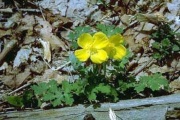Difference between revisions of "Celandine"
Jump to navigation
Jump to search
(username removed) |
(username removed) |
||
| Line 12: | Line 12: | ||
== Authority == | == Authority == | ||
| − | * | + | * R.J. Adrosko, ''Natural Dyes in the United States'', Smithsonian Institution Press, Washington, DC, 1968 |
| − | * | + | * R.D. Harley, ''Artists' Pigments c. 1600-1835'', Butterworth Scientific, London, 1982 |
| − | * | + | * Random House, ''Webster's Encyclopedic Unabridged Dictionary of the English Language'', Grammercy Book, New York, 1997 |
[[Category:Materials database]] | [[Category:Materials database]] | ||
Revision as of 06:43, 24 July 2013
Description
A yellow to orange dye obtained from the greater celandine, Chelidonium majus, plant. The celandine dye is extracted from the ground roots, stems, and leaves. It produces a yellow dye with good lightfastness using an aluminum mordant.
Synonyms and Related Terms
Chelidonium majus (greater celandine); swallowwort; tetterwort; fellonwort; wartweed; kill-wart; devil's milk; celidonia (It.)
Authority
- R.J. Adrosko, Natural Dyes in the United States, Smithsonian Institution Press, Washington, DC, 1968
- R.D. Harley, Artists' Pigments c. 1600-1835, Butterworth Scientific, London, 1982
- Random House, Webster's Encyclopedic Unabridged Dictionary of the English Language, Grammercy Book, New York, 1997
